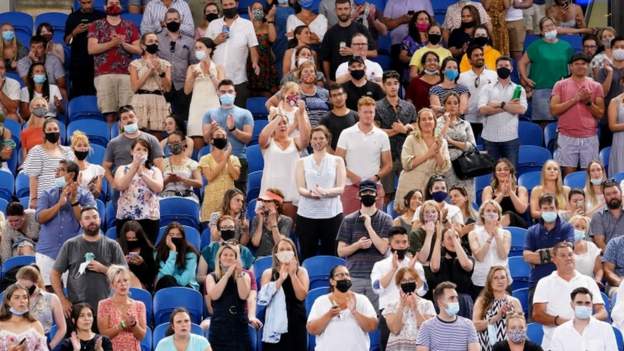
Australian Open players savoured the atmosphere of a crowd hours before Melbourne Park closes its doors to fans because of a snap five-day lockdown.
The sight of unmasked spectators and the sound of raucous cheers at the Grand Slam has been a glorious reminder of the best parts of live sport at a time when empty stadiums and piped fan noise on TV are the norm.
But it was always a fragile privilege.
Victoria state is entering lockdown to suppress a coronavirus outbreak.
From midnight on Friday until Wednesday people must stay at home, schools are closed and gatherings are banned as Victorian premier Daniel Andrews said a "short, sharp circuit breaker" was needed to combat an outbreak of the UK strain of coronavirus.
It meant that fans were still allowed into Melbourne Park on Friday to watch players including Serena Williams and Naomi Osaka, and will be able to get behind home hope Nick Kyrgios when he takes on Dominic Thiem (08:00 GMT).
The Kyrgios match is in the evening session Australian time and organisers have told ticket-holders they must leave by 11.30pm and be home by midnight, if they are not kept away by the impending lockdown.
Those fans will be missed - and not just by Kyrgios, who said the crowd spurred him on in his thrilling five-set win on Wednesday.
"It's rough. It's going to be a rough few days for I think everyone. But we'll hopefully get through it," 23-time Grand Slam champion Serena Williams said.
"It's not ideal. It's been really fun to have the crowd back, especially here. It's been really cool," she added. "But, you know what, at the end of the day we have to do what's best. Hopefully it will be all right."
Three-time Grand Slam champion Naomi Osaka urged fans on John Cain Arena to give her a rendition of local chant "Aussie, Aussie, Aussie, Oi! Oi! Oi!", telling them: "Thanks for coming out, it's so great to play in front you."
Former world number three Grigor Dimitrov added: "I mean, clearly it's unexpected. [But we are] still being very fortunate to be able to play a Grand Slam tournament in the middle of a pandemic."
The players will enter a biosecure 'bubble' from Saturday morning similar to ones they have experienced at tournaments for much of the pandemic, whereby they are not allowed to leave their hotels or the tournament grounds.
"They've been doing this all year," Australian Open tournament director Craig Tiley said.
"The last five days have been a unique experience for them and the next five will be back to what they know."
Before this outbreak - involving 13 cases stemming from a quarantine worker at a Melbourne hotel - Victoria had not had a local infection for 28 days and the state had largely eliminated the virus.
Last year, in Australia's winter, Melbourne locals endured one of the world's longest and strictest lockdowns to overcome a second wave that led to more than 90% of Australia's 29,000 cases and 909 deaths.
Preparations for the Grand Slam had been mired in controversy, with locals concerned about the influx of so many international players during a global pandemic, and complaints from some players about strict quarantine measures.
The build-up last week was disrupted when a worker at one of the tennis quarantine hotels tested positive, with warm-up events paused and players having to be tested. And the Australian Open itself is being held three weeks later than usual so that players could quarantine for 14 days.
Up to 30,000 fans have been allowed in each day - around 50% of the usual attendance - although the actual numbers attending have fallen well short of that with 22,299 coming through the gates on Thursday.
Fans who had already bought tickets will get their money back and Friday's night session is still open, despite Andrews encouraging Victorians to stay at home.
"It's entirely up to our fans to make their choice," Tiley said. "They'll be coming to a Covid-safe environment... but they will get a refund if they are not comfortable coming."















 Phone: (800) 737. 6040
Phone: (800) 737. 6040 Fax: (800) 825 5558
Fax: (800) 825 5558 Website:
Website:  Email:
Email: 






